Circular Photogalvanic Current in Ni-Doped Cd3As2 Films Epitaxied on GaAs(111)B Substrate
Abstract
1. Introduction
2. Materials and Methods
3. Results and Discussion
4. Conclusions
Author Contributions
Funding
Data Availability Statement
Conflicts of Interest
References
- Liang, T.; Gibson, Q.; Ali, M.N.; Liu, M.; Cava, R.J.; Ong, N.P. Ultrahigh mobility and giant magnetoresistance in the Dirac semimetal Cd3As2. Nat. Mater. 2015, 14, 280. [Google Scholar] [CrossRef]
- Liu, Z.K.; Jiang, J.; Zhou, B.; Wang, Z.J.; Zhang, Y.; Weng, H.M.; Prabhakaran, D.; Mo, S.-K.; Peng, H.; Dudin, P.; et al. A stable three-dimensional topological Dirac semimetal Cd3As2. Nat. Mater. 2014, 13, 677. [Google Scholar] [CrossRef]
- Borisenko, S.; Gibson, Q.; Evtushinsky, D.; Zabolotnyy, V.; Buchner, B.; Cava, R.J. Experimental Realization of a Three-Dimensional Dirac Semimetal. Phys. Rev. Lett. 2014, 113, 027603. [Google Scholar] [CrossRef]
- Neupane, M.; Xu, S.Y.; Sankar, R.; Alidoust, N.; Bian, G.; Liu, C.; Belopolski, I.; Chang, T.R.; Jeng, H.T.; Lin, H. Observation of a three-dimensional topological Dirac semimetal phase in high-mobility Cd3As2. Nat. Commun. 2014, 5, 3786. [Google Scholar] [CrossRef]
- Wang, Z.; Weng, H.; Wu, Q.; Dai, X.; Fang, Z. Three-dimensional Dirac semimetal and quantum transport in Cd3As2. Phys. Rev. B 2013, 88, 125427. [Google Scholar] [CrossRef]
- Zhang, C.; Narayan, A.; Lu, S.; Zhang, J.; Zhang, H.; Ni, Z.; Yuan, X.; Liu, Y.; Park, J.H.; Zhang, E.; et al. Evolution of Weyl orbit and quantum Hall effect in Dirac semimetal Cd3As2. Nat. Commun. 2017, 8, 1272. [Google Scholar] [CrossRef]
- Li, C.Z.; Wang, L.X.; Liu, H.; Wang, J.; Liao, Z.M.; Yu, D.P. Giant negative magnetoresistance induced by the chiral anomaly in individual Cd3As2 nanowires. Nat. Commun. 2015, 6, 10137. [Google Scholar] [CrossRef] [PubMed]
- Narayanan, A.; Watson, M.D.; Blake, S.F.; Bruyant, N.; Drigo, L.; Chen, Y.L.; Prabhakaran, D.; Yan, B.; Felser, C.; Kong, T.; et al. Linear magnetoresistance caused by mobility fluctuations in the n-doped Cd3As2. Phys. Rev. Lett. 2015, 114, 117201. [Google Scholar] [CrossRef] [PubMed]
- Galletti, L.; Schumann, T.; Shoron, O.F.; Goyal, M.; Kealhofer, D.A.; Kim, H.; Stemmer, S. Two-dimensional Dirac fermions in thin films of Cd3As2. Phys. Rev. B 2018, 97, 115132. [Google Scholar] [CrossRef]
- Goyal, M.; Galletti, L.; Salmani-Rezaie, S.; Schumann, T.; Kealhofer, D.A.; Stemmer, S. Thickness dependence of the quantum Hall effect in films of the three-dimensional Dirac semimetal Cd3As2. APL Mater. 2018, 6, 026105. [Google Scholar] [CrossRef]
- Uchida, M.; Nakazawa, Y.; Nishihaya, S.; Akiba, K.; Kriener, M.; Kozuka, Y.; Miyake, A.; Taguchi, Y.; Tokunaga, M.; Nagaosa, N.; et al. Quantum Hall states observed in thin films of Dirac semimetal Cd3As2. Nat. Commun. 2017, 8, 2274. [Google Scholar] [CrossRef] [PubMed]
- Suslov, A.V.; Davydov, A.B.; Oveshnikov, L.N.; Morgun, L.A.; Kugel, K.I.; Zakhvalinskii, V.S.; Pilyuk, E.A.; Kochura, A.V.; Kuzmenko, A.P.; Pudalov, V.M.; et al. Observation of subkelvin superconductivity in Cd3As2 thin films. Phys. Rev. B 2019, 99, 094512. [Google Scholar] [CrossRef]
- Wang, H.; Wang, H.C.; Liu, H.; Hong, L.; Yang, W.; Shuang, J.; Liu, X.J.; Xie, X.C.; Wei, J.; Wang, J. Observation of superconductivity induced by a point contact on 3D Dirac semimetal Cd3As2 crystals. Nat. Mater. 2016, 15, 38. [Google Scholar] [CrossRef] [PubMed]
- Akrap, A.; Hakl, M.; Tchoumakov, S.; Crassee, I.; Kuba, J.; Goerbig, M.O.; Homes, C.C.; Caha, O.; Nov’ak, J.; Teppe, F.; et al. Magneto-optical signature of massless Kane electrons in Cd3As2. Phys. Rev. Lett. 2016, 117, 136401. [Google Scholar] [CrossRef]
- Zhu, C.; Wang, F.; Meng, Y.; Xiang, Y.; Xiu, F.; Luo, H.; Wang, Y.; Li, J.; Lv, X.; Liang, H.; et al. A robust and tuneable mid-infrared optical switch enabled by bulk Dirac fermions. Nat. Commun. 2017, 8, 14111. [Google Scholar] [CrossRef] [PubMed]
- Sun, Y.; Meng, Y.; Jiang, H.; Qin, S.; Yang, Y.; Xiu, F.; Shi, Y.; Zhu, S.; Wang, F. Dirac semimetal saturable absorber with actively tunable modulation depth. Opt. Lett. 2019, 44, 582. [Google Scholar] [CrossRef]
- Yang, M.; Wang, J.; Han, J.; Ling, J.; Ji, C.; Kong, X.; Liu, X.; Huang, Z.; Gou, J.; Liu, Z.; et al. Enhanced Performance of Wideband Room Temperature Photodetector Based on Cd3As2 Thin Film/Pentacene Heterojunction. ACS Photon. 2018, 5, 3438. [Google Scholar] [CrossRef]
- Dai, Z.J.; Manjappa, M.; Yang, Y.K.; Tan, T.C.W.; Qiang, B.; Han, S.; Wong, L.J.; Xiu, F.X.; Liu, W.; Singh, R. High Mobility 3D Dirac Semimetal (Cd3As2) for Ultrafast Photoactive Terahertz Photonics. Adv. Funct. Mater. 2021, 17, 2011011. [Google Scholar] [CrossRef]
- Yavarishad, N.; Hosseini, T.; Kheirandish, E.; Weber, C.P.; Kouklin, N. Room-temperature self-powered energy photodetector based on optically induced Seebeck effect in Cd3As2. Appl. Phys. Express 2017, 10, 052201. [Google Scholar] [CrossRef]
- Chorsi, H.T.; Yue, S.; Iyer, P.P.; Goyal, M.; Schumann, T.; Stemmer, S.; Liao, B.; Schuller, J.A. Widely Tunable Optical and Thermal Properties of Dirac Semimetal Cd3As2. Adv. Opt. Mater. 2020, 8, 1901192. [Google Scholar] [CrossRef]
- Ganichev, S.D.; Prettl, W. Spin photocurrents in quantum wells. J. Phys. Condens. Matter 2003, 15, 935. [Google Scholar] [CrossRef]
- Ivchenko, E.L. Circular Photo-Galvanic and Spin-Galvanic Effects. Lect. Notes Phys. 2005, 658, 23–50. [Google Scholar]
- Ganichev, S.D.; Ivchenko, E.L.; Danilov, S.N.; Eroms, J.; Wegscheider, W.; Weiss, D.; Prettl, W. Conversion of Spin into Directed Electric Current in Quantum Wells. Phys. Rev. Lett. 2001, 86, 4358. [Google Scholar] [CrossRef] [PubMed]
- Diehl, H.; Shalygin, V.A.; Bel’kov, V.V.; Hoffmann, C.; Danilov, S.N.; Herrle, T.; Tarasenko, S.A.; Schuh, D.; Gerl, C.; Wegscheider, W.; et al. Spin photocurrents in (110)-grown quantum well structures. New J. Phys. 2007, 9, 349. [Google Scholar] [CrossRef]
- He, X.W.; Shen, B.; Chen, Y.H.; Zhang, Q.; Han, K.; Yin, C.M.; Tang, N.; Xu, F.J.; Tang, C.G.; Yang, Z.J.; et al. Anomalous Photogalvanic Effect of Circularly Polarized Light Incident on the Two-Dimensional Electron Gas in AlxGa1-xN/GaN Heterostructures at Room Temperature. Phys. Rev. Lett. 2008, 101, 147402. [Google Scholar] [CrossRef]
- Yang, C.L.; He, H.T.; Ding, L.; Cui, L.J.; Zeng, Y.P.; Wang, J.N.; Ge, W.K. Spectral Dependence of Spin Photocurrent and Current-Induced Spin Polarization in an InGaAs/InAlAs Two-Dimensional Electron Gas. Phys. Rev. Lett. 2006, 96, 186605. [Google Scholar] [CrossRef] [PubMed]
- Plank, H.; Ganichev, S.D. A review on terahertz photogalvanic spectroscopy of Bi2Te3- and Sb2Te3-based three dimensional topological insulators. Solid State Electron. 2018, 147, 44. [Google Scholar] [CrossRef]
- McIver, J.W.; Hsieh, D.; Steinberg, H.; Jarillo-Herrero, P.; Gedik, N. Control over topological insulator photocurrents with light polarization. Nat. Nanotechnol. 2011, 7, 96. [Google Scholar] [CrossRef]
- Pan, Y.; Wang, Q.Z.; Yeats, A.L.; Pillsbury, T.; Flanagan, T.C.; Richardella, A.; Zhang, H.J.; Awschalom, D.D.; Liu, C.X.; Samarth, N. Helicity dependent photocurrent in electrically gated (Bi1-xSbx)2Te3 thin films. Nat. Commun. 2017, 8, 1037. [Google Scholar] [CrossRef] [PubMed]
- Yu, J.L.; Zhu, K.J.; Zeng, X.L.; Chen, L.; Chen, Y.H.; Liu, Y.; Yin, C.M.; Cheng, S.Y.; Lai, Y.F.; Huang, J.; et al. Helicity-dependent photocurrent of the top and bottom Dirac surface states of epitaxial thin films of three-dimensional topological insulators Sb2Te3. Phys. Rev. B 2019, 100, 235108. [Google Scholar] [CrossRef]
- Yu, J.L.; Zeng, X.L.; Zhang, L.G.; He, K.; Cheng, S.Y.; Lai, Y.F.; Huang, W.; Chen, Y.H.; Yin, C.M.; Xue, Q.K. Photoinduced Inverse Spin Hall Effect of Surface States in the Topological Insulator Bi2Se3. Nano Lett. 2017, 17, 7878. [Google Scholar] [CrossRef]
- Gao, Y.; Kaushik, S.; Philip, E.J.; Li, Z.; Qin, Y.; Liu, Y.P.; Zhang, W.L.; Su, Y.L.; Chen, X.; Weng, H.; et al. Chiral terahertz wave emission from the Weyl semimetal TaAs. Nat. Commun. 2020, 11, 720. [Google Scholar] [CrossRef]
- Sun, K.; Sun, S.-S.; Wei, L.-L.; Guo, C.; Tian, H.-F.; Chen, G.-F.; Yang, H.-X.; Li, J.-Q. Circular Photogalvanic Effect in the Weyl Semimetal TaAs. Chin. Phys. Lett. 2017, 34, 117203. [Google Scholar] [CrossRef]
- Sirica, N.; Tobey, R.I.; Zhao, L.X.; Chen, G.F.; Xu, B.; Yang, R.; Shen, B.; Yarotski, D.A.; Bowlan, P.; Trugman, S.A.; et al. Tracking ultrafast photocurrents in the Weyl semimetal TaAs using THz emission spectroscopy. Phys. Rev. Lett. 2019, 122, 197401. [Google Scholar] [CrossRef] [PubMed]
- Leppenen, N.V.; Ivchenko, E.L.; Golub, L.E. Circular Photocurrent in Weyl Semimetals with Mirror Symmetry. J. Exp. Theor. Phys. 2019, 129, 139. [Google Scholar] [CrossRef]
- Golub, L.E.; Ivchenko, E.L. Circular and magnetoinduced photocurrents in Weyl semimetals. Phys. Rev. B 2018, 98, 075305. [Google Scholar] [CrossRef]
- de Juan, F.; Grushin, A.G.; Morimoto, T.; Moore, J.E. Quantized circular photogalvanic effect in Weyl semimetals. Nat. Commun. 2017, 8, 15995. [Google Scholar] [CrossRef] [PubMed]
- Ji, Z.; Liu, G.; Addison, Z.; Liu, W.; Yu, P.; Gao, H.; Liu, Z.; Rappe, A.M.; Kane, C.L.; Mele, E.J.; et al. Spatially dispersive circular photogalvanic effect in a Weyl semimetal. Nat. Mater. 2019, 18, 955. [Google Scholar] [CrossRef] [PubMed]
- Chan, C.K.; Lindner, N.H.; Refael, G.; Lee, P.A. Photocurrents in Weyl semimetals. Phys. Rev. B 2017, 95, 041104. [Google Scholar] [CrossRef]
- Karch, J.; Olbrich, P.; Schmalzbauer, M.; Brinsteiner, C.; Wurstbauer, U.; Glazov, M.M.; Tarasenko, S.A.; Ivchenko, E.L.; Weiss, D.; Eroms, J.; et al. Photon helicity driven electric currents in graphene. arXiv 2010, arXiv:1002.1047. [Google Scholar]
- Jiang, C.; Shalygin, V.A.; Panevin, V.Y.; Danilov, S.N.; Glazov, M.M.; Yakimova, R.; Lara-Avila, S.; Kubatkin, S.; Ganichev, S.D. Helicity-dependent photocurrents in graphene layers excited by midinfrared radiation of a CO2 laser. Phys. Rev. B 2011, 84, 125429. [Google Scholar] [CrossRef]
- Glazov, M.M.; Ganichev, S.D. High frequency electric field induced nonlinear effects in graphene. Phys. Rep. 2014, 535, 101. [Google Scholar] [CrossRef]
- Ganichev, S.D.; Weiss, D.; Eroms, J. Terahertz Electric Field Driven Electric Currents and Ratchet Effects in Graphene. Ann. Phys. 2017, 529, 1600406. [Google Scholar] [CrossRef]
- Qian, X.; Cao, B.; Wang, Z.; Shen, X.; Soci, C.; Eginligil, M.; Yu, T. Carrier density and light helicity dependence of photocurrent in mono- and bilayer graphene. Semicond. Sci. Technol. 2018, 33, 114008. [Google Scholar] [CrossRef]
- Hosur, P. Circular photogalvanic effect on topological insulator surfaces: Berry-curvature-dependent response. Phys. Rev. B 2011, 83, 035309. [Google Scholar] [CrossRef]
- Junck, A.; Refael, G.; Oppen, F.V. Photocurrent response of topological insulator surface states. Phys. Rev. B 2013, 88, 075144. [Google Scholar] [CrossRef]
- Liang, G.; Zhai, G.; Ma, J.; Wang, H.; Zhao, J.; Wu, X.; Zhang, X. Strain-induced circular photogalvanic current in Dirac semimetal Cd3As2 film epitaxied on GaAs (111)B substrate. Nanoscale 2022, 14, 2383–2392. [Google Scholar] [CrossRef]
- Wang, B.M.; Zhu, Y.; Travaglini, H.C.; Savrasov, S.Y.; Yu, D. Schottky Electric Field Induced Circular Photogalvanic Effect in Cd3As2 Nanobelts. arXiv 2022, arXiv:2210.03819. [Google Scholar]
- Young, S.M.; Zaheer, S.; Teo, J.C.; Kane, C.L.; Mele, E.J.; Rappe, A.M. Dirac Semimetal in Three Dimensions. Phys. Rev. Lett. 2012, 108, 140405. [Google Scholar] [CrossRef]
- Pan, H.; Wu, M.; Liu, Y.; Yang, S.A. Electric control of topological phase transitions in Dirac semimetal thin films. Sci. Rep. 2015, 5, 14639. [Google Scholar] [CrossRef] [PubMed]
- Shao, D.; Ruan, J.; Wu, J.; Chen, T.; Guo, Z.; Zhang, H.; Sun, J.; Sheng, L.; Xing, D. Strain-induced quantum topological phase transitions in Na3Bi. Phys. Rev. B 2017, 96, 075112. [Google Scholar] [CrossRef]
- Jin, H.; Dai, Y.; Ma, Y.D.; Li, X.; Wei, W.; Yu, L.; Huang, B. The electronic and magnetic properties of transition-metal element doped three-dimensional topological Dirac semimetal Cd3As2. J. Mater. Chem. C 2015, 3, 3547. [Google Scholar] [CrossRef]
- Liu, Y.; Tiwari, R.; Narayan, A.; Jin, Z.; Yuan, X.; Zhang, C.; Chen, F.; Li, L.; Xia, Z.; Sanvito, S.; et al. Cr doping induced negative transverse magnetoresistance in Cd3As2 thin films. Phys. Rev. B 2018, 97, 085303. [Google Scholar] [CrossRef]
- Yuan, X.; Chen, P.H.; Zhang, L.Q.; Zhang, C.; Wang, J.Y.; Liu, Y.W.; Sun, Q.; Zhou, P.; Zhang, D.W.; Hu, Z.G.; et al. Direct observation of landau level resonance and mass generation in Dirac semimetal Cd3As2 thin films. Nano Lett. 2017, 17, 2211. [Google Scholar] [CrossRef]
- Zakhvalinskii, V.S.; Nikulicheva, T.B.; Lähderanta, E.; Shakhov, M.A.; Nikitovskaya, E.A.; Taran, S.V. Anomalous cyclotron mass dependence on the magnetic field and Berry’s phase in (Cd1–x–yZnxMny)3As2 solid solutions. J. Phys. Condens. Matter 2017, 29, 455701. [Google Scholar] [CrossRef]
- Sun, Y.; Meng, Y.; Dai, R.; Yang, Y.; Xu, Y.; Zhu, S.; Shi, Y.; Xiu, F.; Wang, F. Slowing down photocarrier relaxation in Dirac semimetal Cd3As2 via Mn doping. Opt. Lett. 2019, 44, 4103–4106. [Google Scholar] [CrossRef] [PubMed]
- Wang, H.; Ma, J.; Wei, Q.; Zhao, J. Mn doping effects on the gate-tunable transport properties of Cd3As2 films epitaxied on GaAs. J. Semicond. 2020, 41, 072903. [Google Scholar] [CrossRef]
- Ma, J.L. Molecular-Beam Epitaxy Growth and Physical Properties of Mn-Based Spintronic Materials. Ph.D. Thesis, University of Chinese Academy of Sciences, Beijing, China, 2019. [Google Scholar]
- Zhai, G.H. The Carrier Dynamics Study of Dirac Semimetal Cd3As2. Ph.D. Thesis, University of Chinese Academy of Sciences, Beijing, China, 2021. [Google Scholar]
- Hase, M.; Ishioka, K.; Demsar, J.; Ushida, K.; Kitajima, M. Ultrafast dynamics of coherent optical phonons and nonequilibrium electrons in transition metals. Phys. Rev. B 2005, 71, 184301. [Google Scholar] [CrossRef]
- Yu, J.; Cheng, S.; Lai, Y.; Zheng, Q.; Zhu, L.; Chen, Y.; Ren, J. Temperature dependence of spin photocurrent spectra induced by Rashba- and Dresselhaus-type circular photogalvanic effect at inter-band excitation in InGaAs/AlGaAs quantum wells. Opt. Express 2015, 23, 27250–27259. [Google Scholar] [CrossRef]
- Wang, Y.M.; Yu, J.L.; Zeng, X.L.; Chen, Y.H.; Liu, Y.; Cheng, S.Y.; Lai, Y.F.; Yin, C.M.; He, K.; Xue, Q.K. Temperature and excitation wavelength dependence of circular and linear photogalvanic effect in a three dimensional topological insulator Bi2Se3. J. Phys. Condens. Matter 2019, 31, 415702. [Google Scholar] [CrossRef]
- Eldridge, P.S.; Leyland, W.; Lagoudakis, P.G.; Karimov, O.Z.; Henini, M.; Taylor, D.; Phillips, R.T.; Harley, R.T. All-optical measurement of Rashba coefficient in quantum wells. Phys. Rev. B 2008, 77, 125344. [Google Scholar] [CrossRef]
- Zhai, G.; Ma, J.; Wang, H.; Ye, J.; Li, T.; Li, Y.; Liang, G.; Zhao, J.; Wu, X.; Zhang, X. Photoexcited carrier dynamics of thin film Cd3As2 grown on a GaAs(111)B substrate by molecular beam epitaxy. Phys. Rev. B 2021, 104, 094302. [Google Scholar] [CrossRef]
- Yang, Y.; Zhou, J.; Xie, X.; Zhang, X.; Li, Z.; Liu, S.; Ai, L.; Ma, Q.; Leng, P.; Zhao, M.; et al. Photodetection and Infrared Imaging Based on Cd3As2 Epitaxial Vertical Heterostructures. ACS Nano 2022, 16, 12244–12252. [Google Scholar] [CrossRef] [PubMed]
- Lu, W.; Ge, S.; Liu, X.; Lu, H.; Li, C.; Lai, J.; Zhao, C.; Liao, Z.; Jia, S.; Sun, D. Ultrafast relaxation dynamics of photoexcited Dirac fermions in the three-dimensional Dirac semimetal Cd3As2. Phys. Rev. B 2017, 95, 024303. [Google Scholar] [CrossRef]
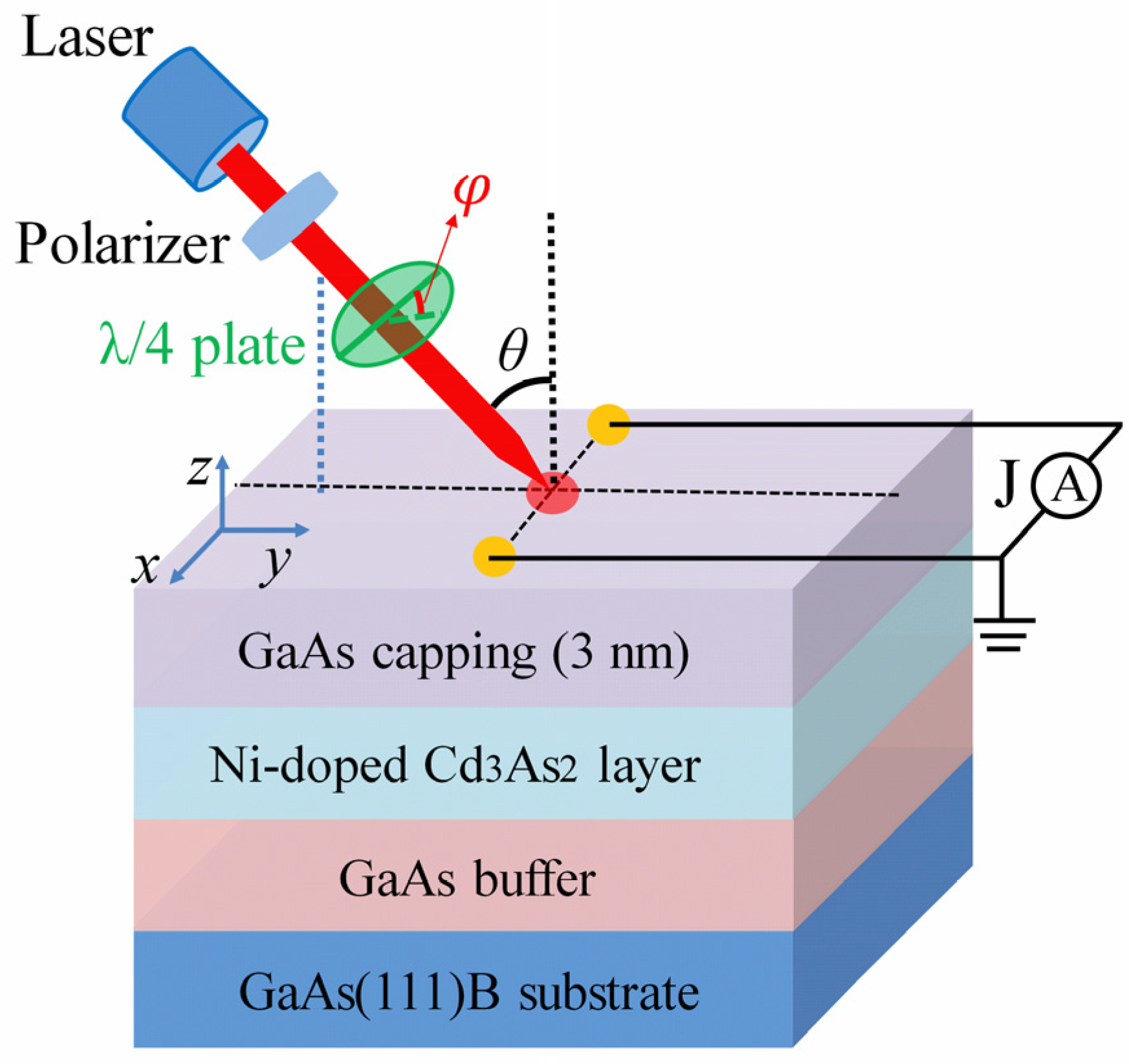

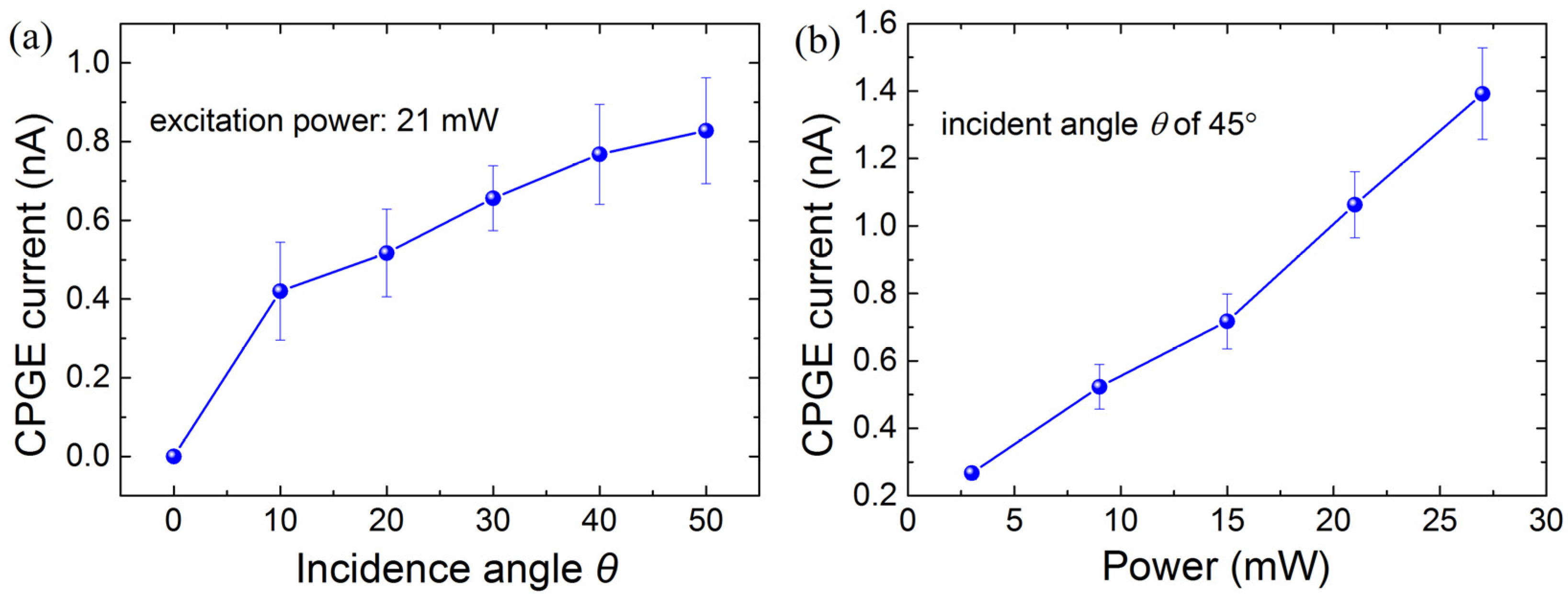
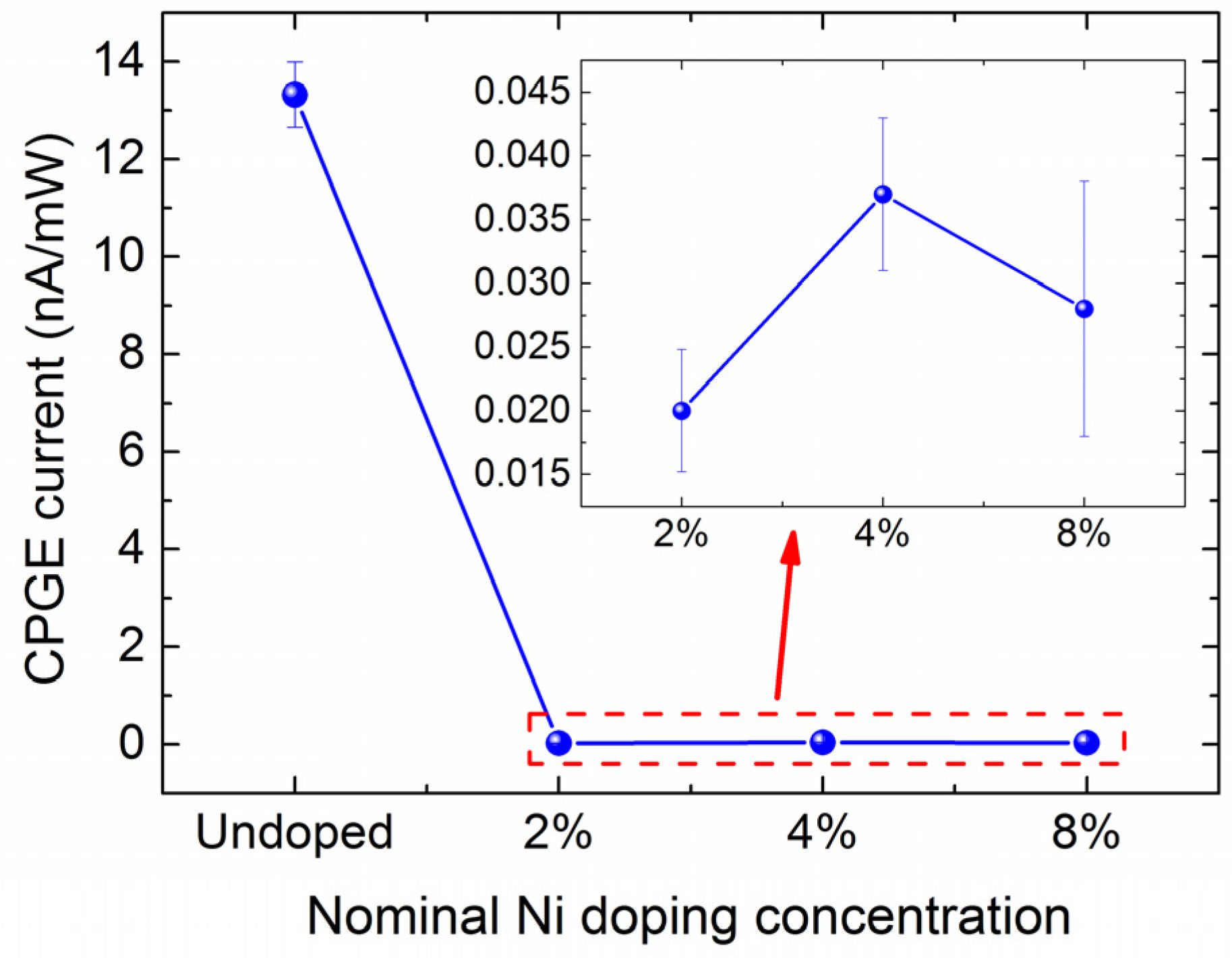
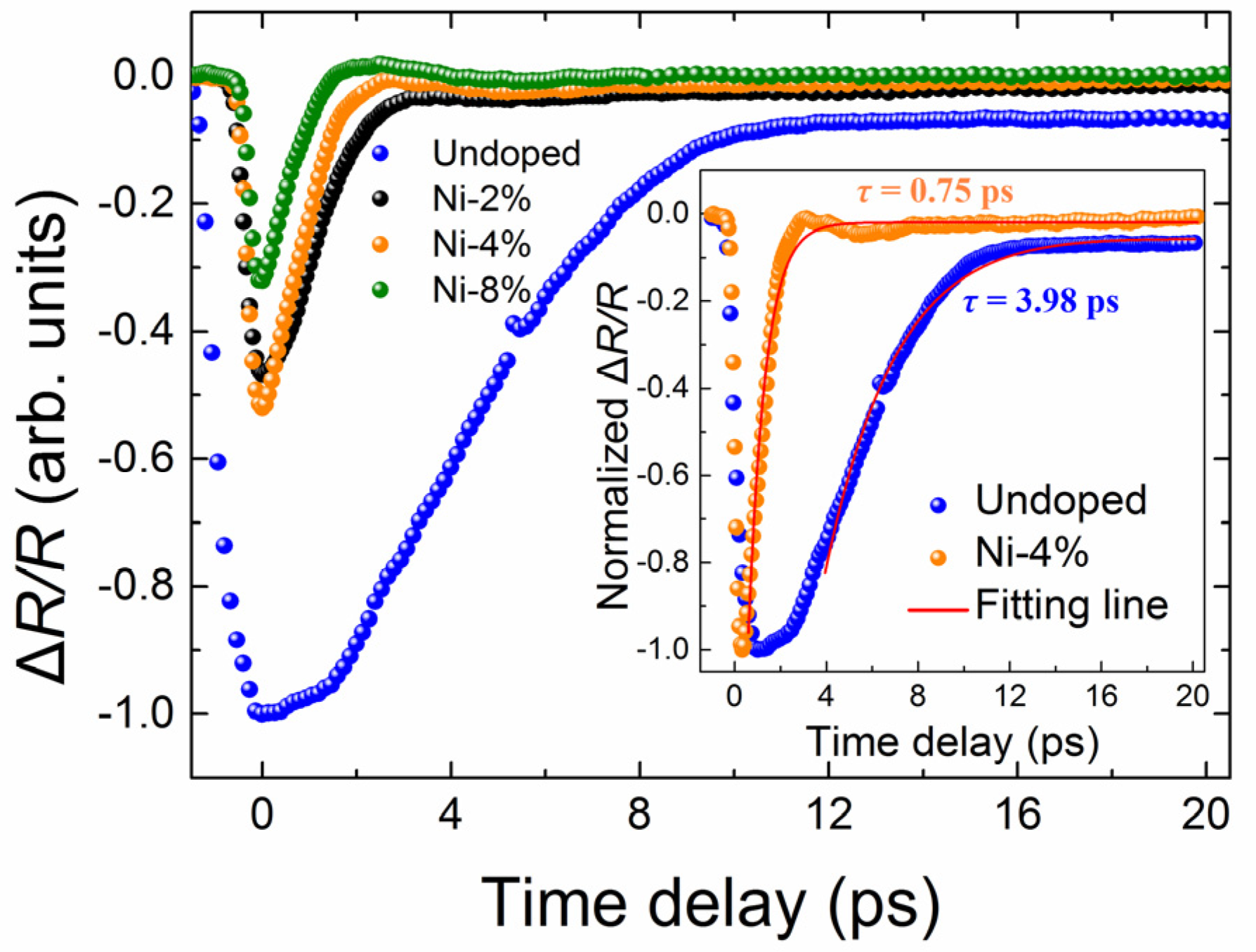
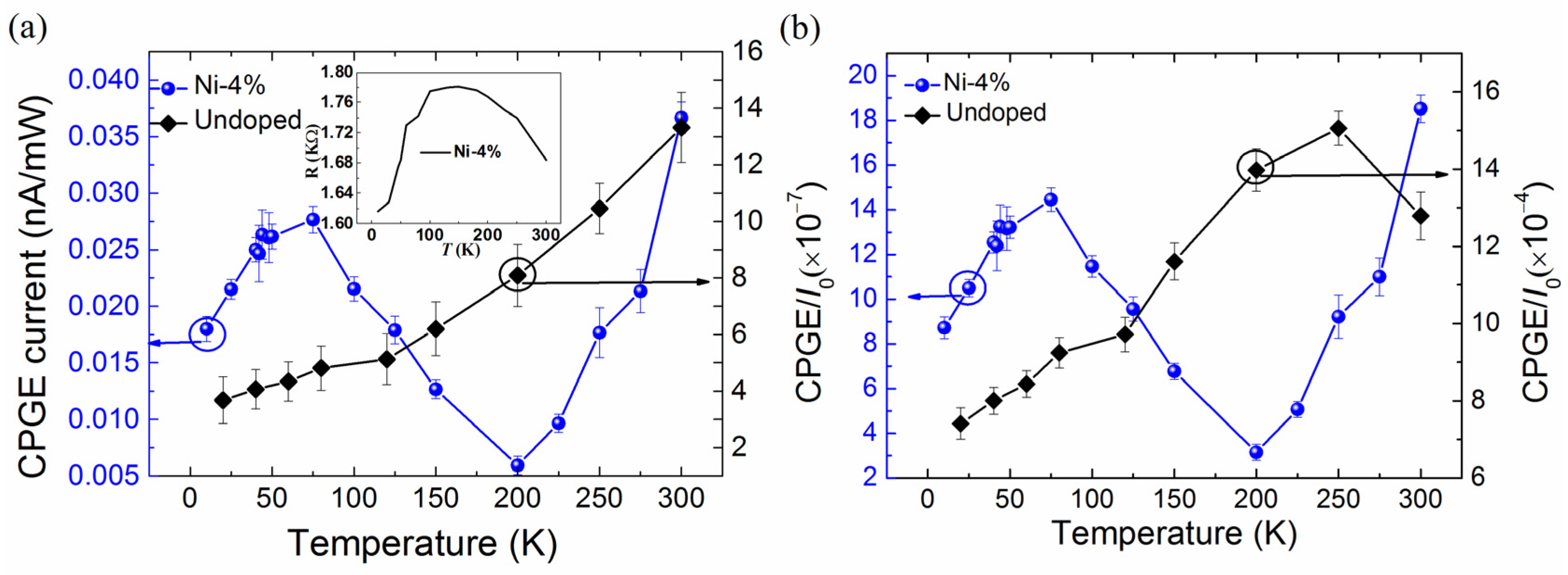
| Sample | Undoped | Sample-A | Sample-B | Sample-C |
|---|---|---|---|---|
| Eectron density (cm−2) | 7.8 × 1011 | 8.0 × 1011 | 1.4 × 1012 | 1.1 × 1012 |
| Hall mobility (cm2 V−1 s−1) | 710 | 1000 | 560 | 260 |
Disclaimer/Publisher’s Note: The statements, opinions and data contained in all publications are solely those of the individual author(s) and contributor(s) and not of MDPI and/or the editor(s). MDPI and/or the editor(s) disclaim responsibility for any injury to people or property resulting from any ideas, methods, instructions or products referred to in the content. |
© 2023 by the authors. Licensee MDPI, Basel, Switzerland. This article is an open access article distributed under the terms and conditions of the Creative Commons Attribution (CC BY) license (https://creativecommons.org/licenses/by/4.0/).
Share and Cite
Liang, G.; Zhai, G.; Ma, J.; Wang, H.; Zhao, J.; Wu, X.; Zhang, X. Circular Photogalvanic Current in Ni-Doped Cd3As2 Films Epitaxied on GaAs(111)B Substrate. Nanomaterials 2023, 13, 1979. https://doi.org/10.3390/nano13131979
Liang G, Zhai G, Ma J, Wang H, Zhao J, Wu X, Zhang X. Circular Photogalvanic Current in Ni-Doped Cd3As2 Films Epitaxied on GaAs(111)B Substrate. Nanomaterials. 2023; 13(13):1979. https://doi.org/10.3390/nano13131979
Chicago/Turabian StyleLiang, Gaoming, Guihao Zhai, Jialin Ma, Hailong Wang, Jianhua Zhao, Xiaoguang Wu, and Xinhui Zhang. 2023. "Circular Photogalvanic Current in Ni-Doped Cd3As2 Films Epitaxied on GaAs(111)B Substrate" Nanomaterials 13, no. 13: 1979. https://doi.org/10.3390/nano13131979
APA StyleLiang, G., Zhai, G., Ma, J., Wang, H., Zhao, J., Wu, X., & Zhang, X. (2023). Circular Photogalvanic Current in Ni-Doped Cd3As2 Films Epitaxied on GaAs(111)B Substrate. Nanomaterials, 13(13), 1979. https://doi.org/10.3390/nano13131979






